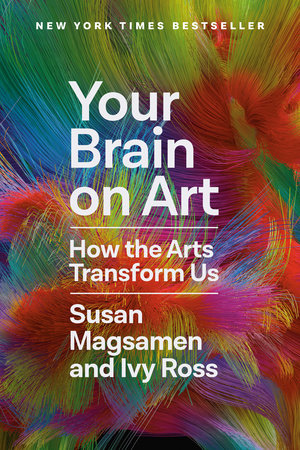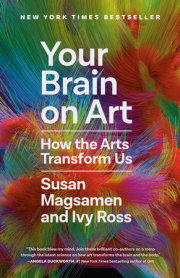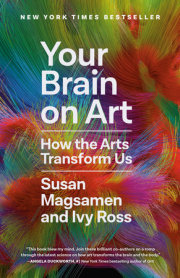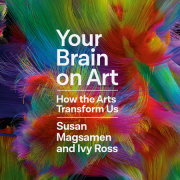Chapter 1
The Anatomy of the Arts
There is a vitality, a life force, an energy, a quickening that is translated through you into action, and because there is only one of you in all of time, this expression is unique. —Martha Graham, dancer and choreographer
We made a bold assertion in the Introduction. We told you that arts and aesthetic experiences will improve your health and well-being and enhance your ability to learn and flourish.
So let’s lay the groundwork for why that’s true.
We’re going to start by showing you some foundational science and offering a quick tour through your body to illuminate the ways in which you are wired for the arts. By first showing you what is going on inside of you, you’ll better appreciate all that follows in the book, which is how the arts and aesthetics affect your body and mind. You can think of this chapter as your arts anatomy cheat sheet.
Knowing how your senses work is key to understanding the transformative nature of the arts and aesthetics in your life. If you took the aesthetic mindset survey prior to this chapter, you have a better idea of how you experience the arts and the extent to which you tune in to your aesthetic surroundings. Let’s expand on that with an exercise to connect you to the sensory experiences you are having right now.
To begin, get comfortable where you are. Breathe in through your nose. What do you smell? Close your eyes and concentrate on this one sense. Maybe there’s a cup of your morning coffee, a glass of red wine, or a candle nearby with a familiar scent. Keep breathing. What do you notice next, beyond those first impressions? If you were trained as a sommelier or a perfumer, you would know those initial smells are the top notes, and you would identify numerous others that exist just below them. Perhaps there’s a musty odor from a dusty bookshelf, or the distinctive smell of petrichor through an open window, that incredible earthy scent that comes when a rain drenches a dry landscape.
Smell is one of the oldest senses in terms of human evolution. Your nose can detect 1 trillion odors with over 400 types of scent receptors whose cells are renewed every thirty to sixty days. In fact, your sense of smell is so good that you can identify some scents better than a dog can.
Microscopic molecules released by substances around you stimulate your scent receptors. They enter your nose and dissolve in mucus within a membrane called the olfactory epithelium, located a few inches up the nasal cavity from the nostrils. From here, neurons, or nerve cells, which are the fundamental components of your brain and nervous system, send axons, which are long nerve fibers, to the main olfactory bulb. Once there, they connect with cells that detect distinct features of the scent.
Here’s where it gets interesting: the olfactory cortex is located in the temporal lobe of your brain, which broadly affects emotions and memory. This is why smell instantaneously and potently triggers physical and mental responses in you. For instance, the scent of a newborn baby releases the neuropeptide oxytocin, which activates bonding, empathy, and trust, appropriately earning oxytocin the nickname “the love drug.” A single sniff of a certain perfume or cologne can bring you back to a long-forgotten relationship. Several chemicals released when grass gets cut stimulate the amygdala and the hippocampus, helping to reduce stress by lowering cortisol. That’s all because of the olfactory cortex–temporal lobe connection.
Like scent, taste is also a chemical sense: The foods you eat trigger your 10,000-plus taste buds, generating electrical signals that travel from your mouth to an area of the brain called the gustatory cortex. This part of the brain is also believed to process visceral and emotional experiences, which helps to explain how it is that taste is among the most effective sensations for encoding memory. It’s why nutmeg, clove, and cinnamon taste like the fall and winter holidays for those living in America and Europe, while the herbaceous and citrusy marigold flower tastes like celebration in India, where the edible blooms are routinely part of wedding ceremonies. It explains why Susan makes her grandmother’s chicken-and-dumpling recipe when she wants to feel comforted and why Ivy’s go-to is moist chocolate cake inspired by the homemade rich, gooey pudding her grandmother made every Sunday growing up.
Keeping your eyes closed, refocus your attention to your ears. The hum of electrical equipment, the whirl of a fan in a laptop, the sound of chattering birds. Traffic. What’s happening nearby? What can you hear in the distance? Hearing is a complex system that includes brain processes, sensory systems, and sound waves.
Maybe you’re listening to music as you read this chapter. Music and sound are the most researched art form in neuroaesthetics, and we’ll show you some compelling findings throughout the book. Our ability to hear is intricate and precise. Sound from the outside world moves into the ear canal, causing the eardrum to vibrate. These sound waves travel through the ossicles to the cochlea and cause the fluid in the cochlea to move like ocean waves. There are thousands of small hair cells inside of the cochlea, and when the fluid moves, these cells are activated, sending messages to the auditory nerve, which then sends messages to the brain. The auditory cortex, also located in the temporal lobe, sits behind your ears, where memory and perception also occur.
Different tempos, languages, and sound levels affect your emotions, mental activities, and physical reactions. Researchers at Stanford University in California used electroencephalography (EEG) machines to measure brain-wave activity of those listening to music at 60 beats per minute and they saw that alpha waves in the brain synchronized to the beats. The alpha brain wave is associated with relaxation. A slower beat can synchronize the delta brain wave and aid in falling asleep.
And the auditory nerve works both ways: It can signal your ear to dampen outside noise and focus on what the brain perceives as an important sound, which explains why it’s so easy to accidentally startle someone who is absorbed in reading a book or looking at a piece of art. They literally didn’t hear you coming.
We tend to think of sound as overt and recognizable things: a favorite song, the timbre of a lover’s voice, the honk of a car horn. What you’ll learn in this book is that your brain chemically reacts to frequency, vibration, and tone as well, and that these chemical triggers can dramatically alter mood, perception, and even address neurological and emotional ailments.
OK, open your eyes. You are now being flooded by light, color, and the objects in your visual field. For those who have visual impairment, it’s estimated that over 80 percent can differentiate between light and dark, even if you are not able to recognize colors, faces, or shapes.
Our ability to see requires us to process light through a complex system. Your eyes work similarly to a camera. What you see is converted into electrical signals by photoreceptors. The optic nerve then sends these signals to the occipital lobe in the back of the brain and converts them into what you see. It’s here that we perceive, recognize, and appreciate objects, and neuroscientists are discovering that it is one part of this lobe—the lateral occipital area—that contributes to how we process and create aesthetic appreciation of art.
Let’s finish your sensory journey by touching a few things in your surroundings. The nubby fabric of your chair, the smooth surface of a table. Or if you are outside, perhaps the cool bark of a tree or the granular warmth of beach sand. Your fingers, hands, toes, feet, and skin are extraordinarily sensitive, picking up minute cues that trigger physiological and psychological responses. In each of your feet, you have more than 700,000 nerve endings that are constantly taking in physical sensation. Touch receptors in your skin connect to neurons in the spinal cord by way of sensory nerves that reach the thalamus in the middle of the head on top of the brain stem.
Information about touch and texture is then transmitted to the somatosensory cortex, located in the parietal lobe. The somatosensory cortex is critical to processing touch. Neurons that process touch in the brain react differently to diverse features communicated by receptors. Consider how many adjectives we use to describe texture—rough, soft, furry, velvety—and what a rich sensory experience touch is.
Touch is one of the more powerful cognitive communication vehicles. It was one of our first sensory systems to evolve. We share our feelings and emotions through the simple act of holding a hand or sharing a hug. Touch rapidly changes our neurobiology and mental states of mind by releasing the neurotransmitter oxytocin, which, in addition to being the love hormone as we mentioned earlier, is also attributed to feelings of trust, generosity, compassion, and lowered anxiety. Experiments with human touch have shown how the intention of one person—to express sadness or happiness, care or excitement—can be interpreted and mirrored by another person through sense receptors. We can, quite literally, “speak” to one another through touch, because of the way it registers emotional perception in the brain.
Copyright © 2023 by Susan Magsamen. All rights reserved. No part of this excerpt may be reproduced or reprinted without permission in writing from the publisher.











